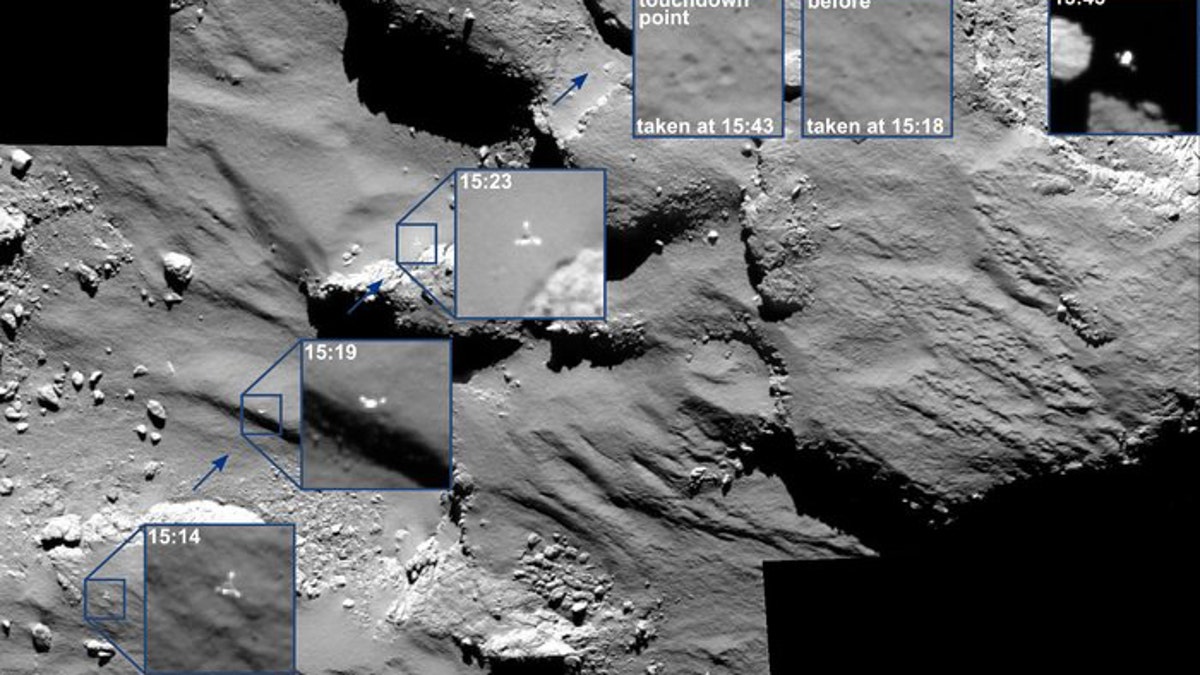
Images showing the Philae lander's journey as it approached and then rebounded from its first touchdown. (ESA/Rosetta/MPS for OSIRIS Team MPS/UPD/LAM/IAA/SSO/INTA/UPM/DASP/IDA)
Scientists are confident that the Philae comet probe, which went into ‘sleep mode’ on Saturday, will wake up again when the comet nears the sun.
Phile made history on Nov. 12 when it became the first probe to land on a comet.
The culmination of an audacious 10-year mission, Philae successfully descended to the comet after separating from its Rosetta mothership. The touchdown, however, was fraught with problems, and the lander bounced twice before landing in the shadow of a cliff – a serious problem for the solar panels designed to provide long-term power to Philae after its primary battery is exhausted.
The European Space Agency faced a race against time to extract as much data from the lander as possible before it entered “idle mode” on Nov. 15 due to lack of sunlight.
However, scientists are optimistic that Philae’s solar panels will eventually receive enough sunlight to power the probe. Before its battery ran out, the agency tilted the lander’s largest solar panel toward the sun in an attempt to generate future power.
"We are very confident at some stage it will wake up again and we can achieve contact," Stephan Ulamec, the lander manager, told The Associated Press.
That should happen next spring, when Philae and the comet it is riding on - called 67P/Churyumov-Gerasimenko - get closer to the sun, warming up a secondary battery on board. A few days of sunshine on the solar panels should be enough to charge the battery sufficiently to conduct science runs, said Ulamec.
Known as a “short period comet,” 67P/Churyumov-Gerasimenko takes 6.6 years to orbit the sun.
There is still uncertainty, however, about the probe’s exact location, although the ESA released images on Monday show its journey across the comet’s surface towards its initial touchdown. Scientists are confident that, by combining data from multiple sources, they will soon reveal the probe’s whereabouts.
Analysis has already started on the scientific information collected by Philae.
Scientists at the German Aerospace Center, DLR, said Monday that an initial review of data the lander sent back 311 million miles to Earth showed the comet's surface is much tougher than previously assumed. There's also evidence of large amounts of ice beneath the lander.
However, scientists are still waiting to find out whether Philae managed to drill into the comet and extract a sample for analysis.
Material beneath the surface of the comet has remained almost unchanged for 4.5 billion years, so the samples would be a cosmic time capsule that scientists are eager to study.
One of the things they are most excited about is the possibility that the mission might help confirm that comets brought the building blocks of life - including water - to Earth.
Despite the challenges faced by Philae, experts have lauded the achievement of landing a probe on a comet.
Roger Franzen, technical manager of the Giant Magellan Telescope at the Australian National University’s Mount Stromlo Observatory just outside Canberra, paid tribute to the ESA’s culture of collaboration.
“Because ESA is a composite of many nations, languages, customs and geographic locations, it has learned by necessity to become methodical and accurate in its planning, design and implementation,” he told FoxNews.com, in an email. “This rigour of process, thought and action combined with aggregate cleverness has led to this success. It is good team work.”
The lander was developed by a European consortium led by the German Aerospace Research Institute (DLR), which includes ESA and institutes from a number of countries, including France, Germany, Ireland, and the United Kingdom. NASA also contributed to the Rosetta mission.
67P/Churyumov-Gerasimenko, which is about 2.5 miles wide, travels at speeds up to 84,000 miles per hour.
Follow James Rogers on Twitter @jamesjrogers
The Associated Press contributed to this report.
